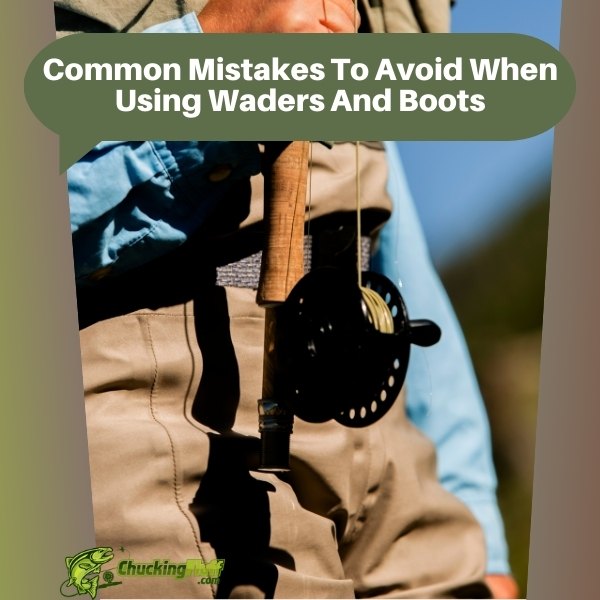| Disclosure: Just to be open and honest the buttons and links you click on in the website will in most cases take you to another website where you can purchase the products I am reviewing. As an Amazon Associate I earn from qualifying purchases. |
Common Mistakes To Avoid When Using Waders And Boots

Waders and boots are indispensable gear for anyone serious about fishing, hunting, or exploring wet and muddy environments. They keep you dry, warm, and safe, whether you’re traversing a stream or navigating marshlands. However, many enthusiasts, from beginners to experienced outdoorsmen, often make mistakes when using these pieces of equipment. These errors can lead to discomfort, reduced durability, and even dangerous situations.
If you’ve ever found yourself struggling with cold feet, leaky waders, or an unfortunate slip on a slick rock, this guide is for you. We’ll dive deep into the most common mistakes people make with waders and boots and show you how to avoid them, ensuring your next adventure is comfortable, safe, and enjoyable.
Quick Post Navigation
Understanding the Role of Waders and Boots
Before jumping into what not to do, it’s essential to understand the role of waders and boots. These gear items aren’t just about keeping you dry. They provide insulation, protect your body from sharp underwater objects, and, most importantly, offer traction on slippery surfaces.
Why Quality Matters
When it comes to waders and boots, you often get what you pay for. High-quality materials and construction can make all the difference. Cheap waders may rip easily, and low-grade boots could have poor traction or inadequate ankle support, putting you at risk of injury. Investing in good-quality gear ensures durability, better performance, and enhanced safety.
Types of Waders and Boots
Waders come in different styles: chest waders, waist-high waders, and hip waders. Each has its unique application, depending on water depth and terrain. Similarly, there are various types of boots, such as felt-soled for slippery surfaces, rubber-soled for general use, and cleated boots for muddy or loose terrains.
Choosing the right combination of waders and boots is essential to match your intended use. Don’t try to wade a deep stream with hip waders or wear felt-soled boots on dry, rocky terrain. Mismatching gear to conditions is a recipe for disaster.
Choosing the Right Fit
Just like you wouldn’t wear oversized shoes or undersized gloves, the fit of your waders and boots is critical. Ill-fitting gear can cause chafing, limit mobility, and even lead to falls.
The Importance of Proper Sizing
Waders that are too tight can restrict movement and cut off circulation, making it difficult to navigate terrain comfortably. On the flip side, loose waders can fill up with water if you fall, which is dangerous and can make getting back up challenging.
Boots that don’t fit right can cause blisters, fatigue, or worse—ankle injuries. Make sure to try on waders and boots with the socks or layers you intend to wear underneath.
Considerations for Different Body Types
Not all waders and boots are made with every body type in mind. If you have a broader chest, larger calves, or unique measurements, consider brands that offer a wider range of sizes or custom options. Properly fitting gear ensures comfort and safety and makes the experience much more enjoyable.
Common Mistakes When Using Waders and Boots
Even with the right gear, improper use can lead to a host of issues. Here’s a rundown of the most common mistakes people make:
Mistake #1: Not Checking for Leaks
It’s easy to forget, but always check your waders for leaks before heading out. Nothing is worse than discovering a slow leak after you’re already waist-deep in icy water. Fill your waders with water (inside out) or use a light to inspect for pinholes and seal them before they become a big problem.
Mistake #2: Wearing the Wrong Layering Underneath
Just like with any outdoor clothing, what you wear underneath your waders is crucial. Cotton absorbs water and sweat, leading to a cold and clammy experience. Opt for moisture-wicking, quick-drying fabrics like merino wool or synthetic blends. Dress in layers to adjust to changing temperatures.
Mistake #3: Choosing the Wrong Boots for the Terrain
Your boots’ sole type is critical. Felt soles are excellent for wet, mossy rocks but are terrible on muddy or dry surfaces. Rubber soles offer versatility but may not provide the grip you need on slick surfaces. Choose cleated soles for muddy conditions, and always consider where you’ll be wading before deciding on your boots.
Mistake #4: Ignoring Weather Conditions
Ignoring weather conditions is a rookie mistake. Hot, sunny days can lead to overheating, while cold, rainy conditions without proper layering can make your experience miserable. Check the weather forecast and dress accordingly. Remember that waders can trap body heat, so even on cooler days, you might find yourself getting too warm if you’re overly layered.
Mistake #5: Not Using a Wading Belt
A wading belt is not just an accessory—it’s a safety feature. It keeps water from flooding your waders if you slip and fall. This can prevent a potentially life-threatening situation where your waders fill with water and drag you down. Always wear a wading belt and keep it snug.
Proper Maintenance and Care
Even the best waders and boots won’t last if they’re not taken care of properly. Maintenance is key to longevity and performance.
Cleaning and Drying Techniques
After each use, rinse your waders and boots with fresh water to remove dirt, salt, and other contaminants. Use a soft brush for scrubbing if needed. For neoprene waders, avoid harsh detergents that can degrade the material.
Drying is crucial to prevent mold and mildew. Hang your waders upside down to allow air to circulate, and store them in a cool, dry place away from direct sunlight.
Storing Waders and Boots Correctly
Never leave your waders and boots crumpled up in the back of your truck. This can cause creases, reduce the waterproofing capability, and lead to unpleasant odors. Store them hanging or laid flat, and avoid high-heat areas like attics or garages in the summer.
Enhancing Safety While Using Waders and Boots
Safety should always be the top priority. Even with the right gear, the environment can pose serious risks.
Understanding Water Currents and Depths
Before stepping into any body of water, take the time to understand the current and depth. Fast currents can knock you off balance, and hidden drop-offs can catch you by surprise. Use a stick or your rod to feel out the depth and firmness of the bottom.
Using a Wading Staff for Stability
A wading staff can be a lifesaver, especially in fast or deep water. It provides an extra point of contact, helping you maintain balance and stability. Use it to probe the area ahead and gauge the bottom’s consistency before stepping forward.
The Importance of Having a Partner
Wading alone is never advisable, especially in unfamiliar or challenging conditions. Having a partner adds a layer of safety, as you can assist each other in case of a slip or fall.
The Environmental Impact of Waders and Boots
Waders and boots don’t just affect you—they can impact the environment as well.
Avoiding the Spread of Invasive Species
Did you know your gear can carry invasive species from one body of water to another? Always clean and disinfect your waders and boots, especially the soles and crevices, to prevent the spread of harmful organisms. Consider using specialized cleaning agents or disinfectants made for outdoor gear.
Conclusion
Waders and boots are essential gear for any serious angler, hunter, or outdoor enthusiast. By avoiding common mistakes like poor fit, lack of maintenance, and improper use, you can ensure your gear serves you well for years to come. Remember, investing time in understanding and caring for your waders and boots will pay off in the long run, making each outdoor adventure safe, comfortable, and enjoyable.
FAQs
Q1: How often should I replace my waders and boots?
A: It depends on usage and maintenance. High-quality gear can last several years with proper care. If you notice leaks, wear, or reduced traction, it’s time to consider a replacement.
Q2: Can I repair a small tear in my waders?
A: Yes, minor tears can be repaired using patch kits designed for waders. For neoprene waders, specialized adhesives work best. Ensure the area is dry and clean before applying any patch.
Q3: What should I do if my boots are slippery?
A: Check if the soles are appropriate for the terrain. You can add aftermarket studs or swap out the soles for better grip, depending on your boot model.
Q4: How do I know if my waders are too tight?
A: If your movement feels restricted or you notice discomfort around the knees and groin when bending or kneeling, your waders might be too tight. Opt for a larger size or different cut.
Q5: Can I wear regular socks with wading boots?
A: Regular socks may cause discomfort and reduce insulation. It’s best to wear moisture-wicking, thermal socks to keep your feet dry and warm, especially in cold conditions.


